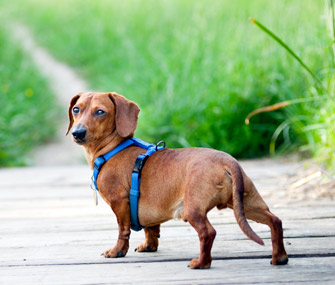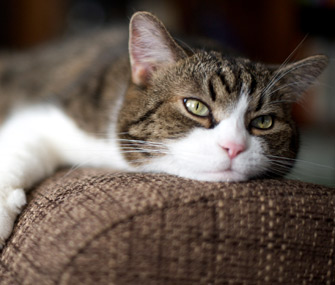10 Unexpected Ways You Could Be Hurting Your Dog or Cat
by Laura Cross
Published on January 16, 2015
Skip To

Here are a few mistakes you might be making, but don’t worry, we’ve also included advice and links to more detailed articles to help you fix them.
You Feed Your Pet From the
Table
Giving your animal a few scraps from the table
may seem harmless enough, but human food can cause a host of problems in cats
in dogs. For one thing, those extra licks and bites of your food add up and
can cause your pet to pack on the pounds. Also, too much rich and fatty food
can lead to pancreatitis — a painful and potentially life-threatening disease.
Finally, some human foods are dangerous or toxic for pets. Household staples
like onions, grapes and chocolate can cause vomiting, diarrhea, upset stomach
or worse. If those risks don’t deter you, consider this: Feeding your pet from the table encourages begging, which is one of the more annoying and undesirable canine behaviors around.

You’re Using the Wrong Collar or the Wrong Size Collar
Finding the perfect collar or harness for your dog or cat will benefit both you and your pet. There are many types of collars and harnesses, and the different kinds can help with issues like pulling, lunging and escaping. Dog trainer Mikkel Becker has great advice on choosing the right collar or harness for your dog. Some dogs are prone to tracheal collapse and might be better off with a harness instead of a collar. Steer clear of corrective collars like choke collars and prong collars. They can cause neck injury, pain and even strangulation. Do your research to find the collar or harness that’s right for you and your pet.Once you’ve determined you have the right type, make sure you get the right size. According to Dr. Marty Becker, if a collar fits correctly you should be able to slip one finger between the skin and collar of a small dog and two fingers between the skin and collar of a large dog. If it’s too loose, your dog could wiggle out of her collar or harness and escape. If it’s too tight, the collar or harness could rub against her skin and hurt her.
There are also collars that are more safe for your cat to wear, including collars that break away if she gets stuck on something.
You Don’t Take Care of Your Pet’s Teeth
More than 85 percent of cats and dogs over 4 years old are affected by dental disease. But daily brushing and regular professional dental cleanings can help keep your pet’s teeth and gums in good health and, best of all, his breath won’t smell so awful. If you continue to ignore your pet’s teeth, he could develop periodontitis, which is the most common cause of tooth loss in cats and dogs. Not to mention that his breath is going to reek.You Leave Food Out All the Time
If you always keep your pet’s bowl filled, you may be contributing to his obesity. Dogs and cats are quite skilled at acting like they’re hungry all the time, but don’t fall for their begging and whining. The fact is, many of us feed our pets way too much — and it’s killing them. An estimated 54 percent of cats and dogs in the United States are overweight or obese. This increases the risk for diabetes, high blood pressure, arthritis, some types of cancer and many other health issues.Next time your animal looks longingly at his empty food bowl, don’t fill it up right away. Stick to a mealtime schedule and ask your vet how much and how many times per day you should feed your pet. And then use a measuring cup to make sure you are giving the right amount. If your pet is a finicky eater or wolfs down his food, he might benefit from a food puzzle or different kind of feeder.

You Let Your Pet Be a Couch Potato
We’ve already told you the risks of pet obesity, but besides keeping your animal’s diet in check, you also need to give him regular exercise so he can maintain a healthy weight. Walking, running and playing with your dog isn’t just beneficial for his physical health, it’s also good for his mental health. A bored dog can become a badly behaved dog who might dig up your yard or chew your furniture. The same can be said for cats, as they also need exercise and mental stimulation. Encourage your kitty to get moving by providing scratchers, laser pointers and interactive toys. And, of course, helping your animal stay active can help keep you active and boost your health.You Feed Your Pet a Vegan Diet
Many vets, including Dr. Marty Becker, believe it’s not a good idea to feed your pet a vegan diet, especially if your furry friend is a cat. Felines are strict carnivores and need meat to live. Otherwise, a cat’s body will break down its muscle tissue to get enough protein. Dogs, on the other hand, could technically have a meat-free diet, but most vets still don’t recommend it. Be sure to talk with your vet about your pet’s diet, as there are many factors that come into play in picking the right food, including the pet’s age and health.You Don’t Take Your Pet to the Vet for Annual Exams
We know: Taking your pet to the vet can be a real chore. Cat owners, we’re especially thinking of you. The mere thought of getting Tiger into his carrier can bring on a headache. But your pet’s annual exam is important for his health and well-being. During your pet’s yearly checkup, your vet will look for weight gain or loss, dental disease and other health problems that might not be evident to you. Your vet can also help spot issues before they become big problems. As your pet ages, you may need to increase that frequency to every six months.
You Don’t Secure Your Pet When You’re in the Car
You always buckle up when you get in the car, so why shouldn’t you buckle in your pet? He is another passenger, after all. If you get in a car accident, a loose cat or dog could become injured, be ejected from the car, or become a projectile and injure you or other passengers. Secure your animal in the car with a crate, harness or other safety restraint every single time he’s in your vehicle. It’s not worth the risk to you, your passengers or your pet. Furthermore, don’t let your dog hang his head out the window. He might enjoy the fresh air and passing scenery, but your pup could jump out, roll the window up on himself or get debris in his eyes.You Feed Your Pet Real Bones
Feeding your dog leftovers is problematic enough, but giving him a real bone could be deadly. Whether it’s from poultry, beef, pork or fish, a real bone can cause your dog to choke, or the bone could shatter and puncture his esophagus, stomach or intestines. Your pup could break a tooth, get a tongue or mouth injury, or have an obstruction that could require surgery. We could go on, but you get the idea: Keep real bones away from your dog.You Yell at Your Pet When She Does Something Wrong
Your first instinct may be to yell at your animal when he pees on the carpet or scratches your couch, but your negative reaction does more harm than good for your pet. In fact, it can actually reinforce the bad behavior. Punishment-based training can temporarily make your animal stop his bad behavior, but over time, the negative reinforcement can lead to aggression and other bad behaviors. Try positive reinforcement training instead. Rewarding good behavior with praise and treats is a much more effective and safe approach.Hopefully you aren’t guilty of too many of these behaviors, but if you are, it is time to begin mending your ways.
More on Vetstreet.com:
- This Common Home Product Is Dangerous to Pets
- 10 Warning Signs of Cancer in Pets
- Best Dog & Cat Breeds If You Have Allergies





